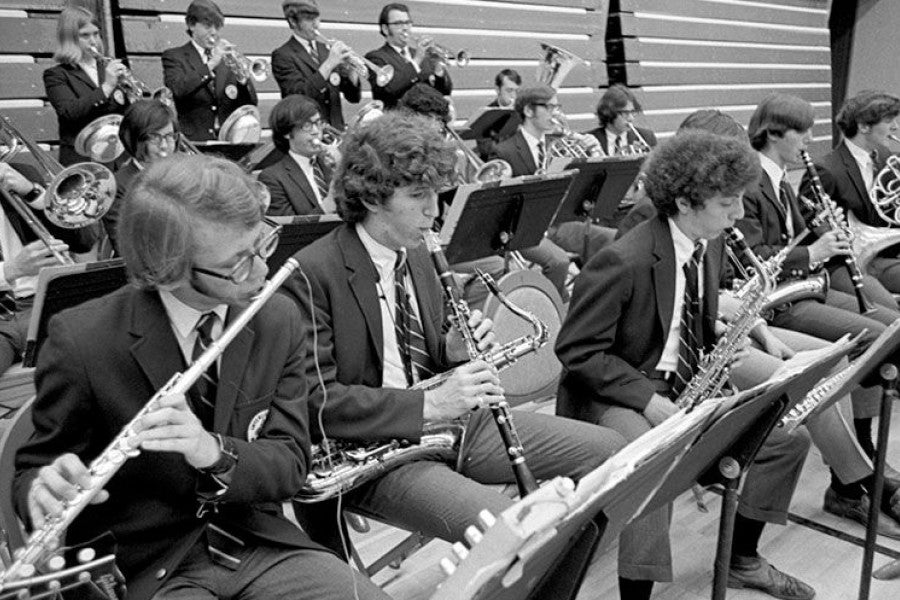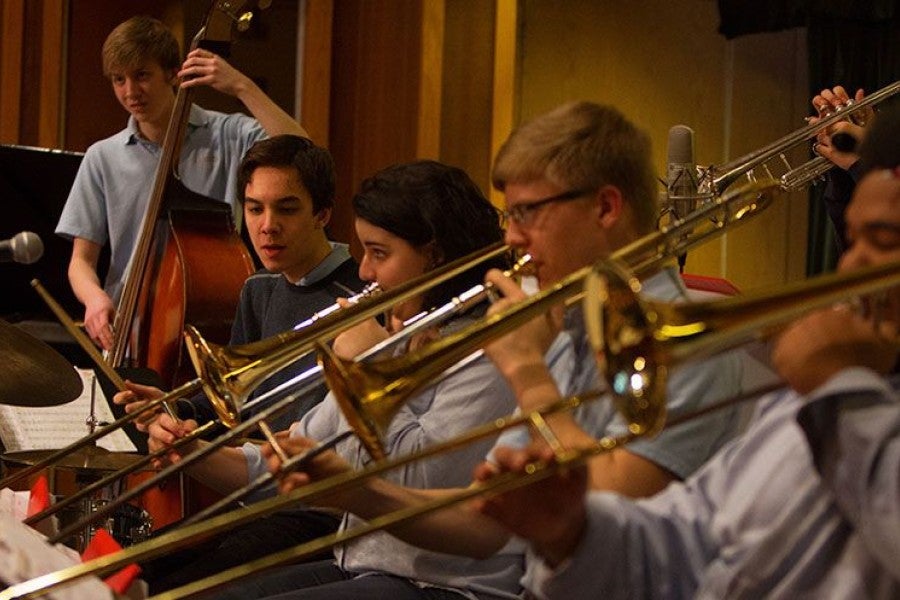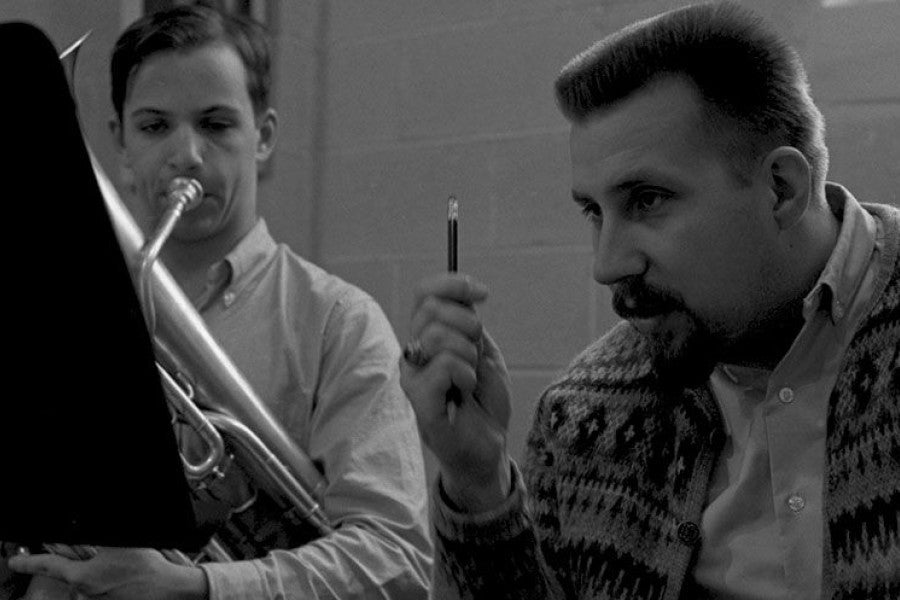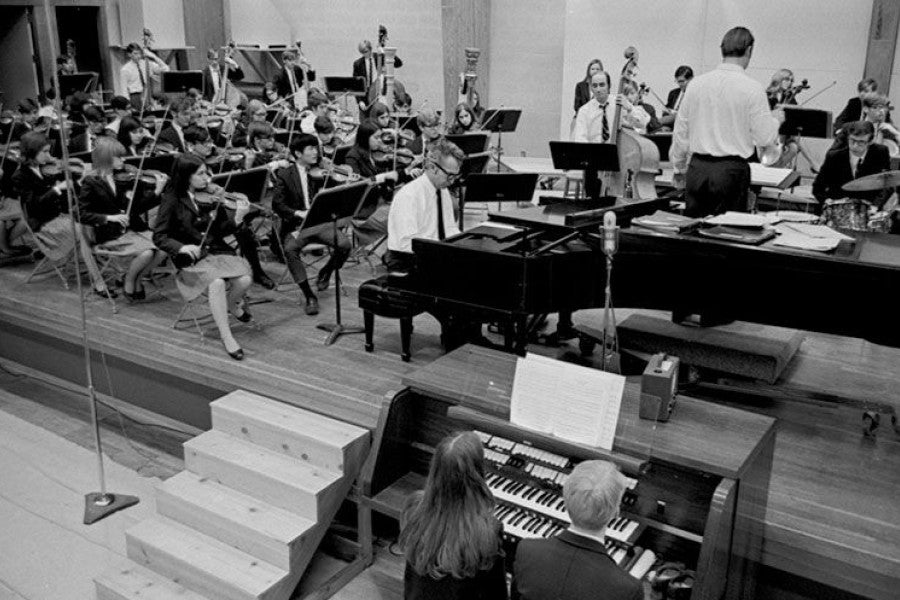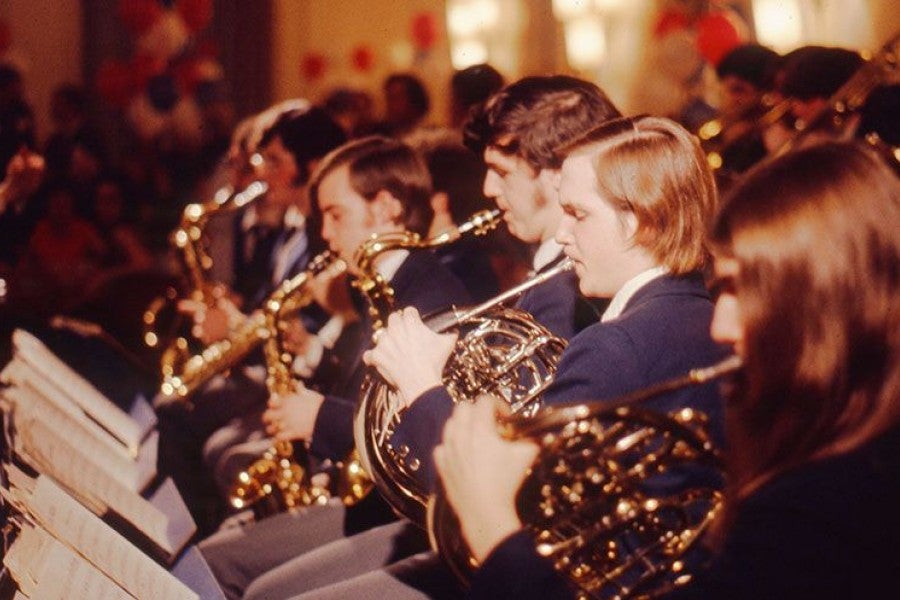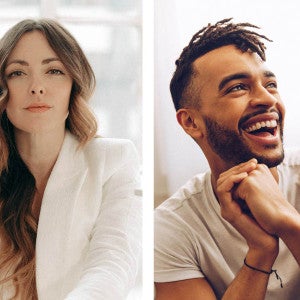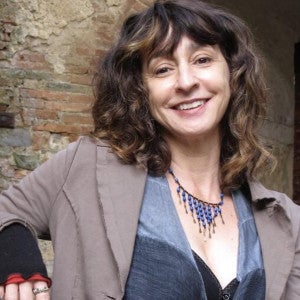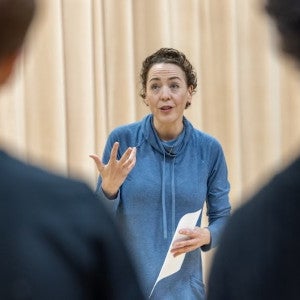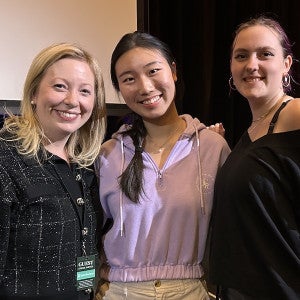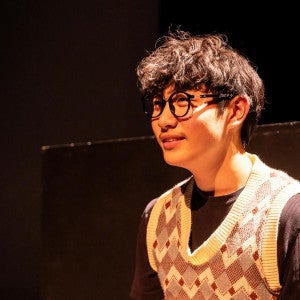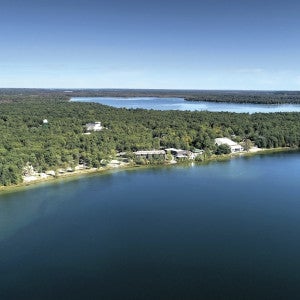Take Five (times ten): 50 years of jazz at Interlochen
A 50th-anniversary retrospective of jazz’s history at Interlochen.
Alumni of Interlochen Arts Camp and Arts Academy know all too well the allure of a Melody Freeze cone.
In the early years of Academy, students had just one hour and 15 minutes in the evening to grab their favorite treats from the campus sweet-shop. But beginning in 1967, a small group of students made the decision to sacrifice their sweet treats for the sweet beats of the Studio Orchestra. And so, the jazz program at Interlochen was born.
The early days
Jazz has had a long and somewhat clouded history with Interlochen. Interlochen’s founder, Joseph Maddy, himself moonlighted as a saxophonist in a jazz club before he found his calling as a high school music instructor and founded the National Music Camp. During the Camp’s first season, Harp Instructor Pasquale Montani founded the Camp’s first faculty jazz ensemble.
Years passed, and although many students and faculty formed their own informal groups to play popular music, the administration was wary of adding a jazz band to the ranks of officially sanctioned ensembles.
David Sporny, the “Bad Cat”
Even before David Sporny was offered the position of Instructor of Trombone at Interlochen Arts Academy in 1966, his presence inspired some degree of conspiracy among students.
For one thing, several members of the trombone studio sneaked up into the attic of the Fine Arts building to watch Sporny’s faculty audition. For another, Sporny sported a goatee. “No one else on faculty had a beard,” Sporny said. “There was all this speculation that if I came to teach here, I would have to shave my beard.” No such stipulation was ever put on Sporny, but the students didn’t know that. “The rumor was that I was a ‘bad cat’ because I wouldn’t shave my goatee,” he said.
The rumors about Sporny’s facial hair proved to be untrue, but another rumor—that Sporny had trained and performed as a jazz musician in college—was soon confirmed. “We knew that Sporny was from the University of Illinois,” said Chris Brubeck (IAC/NMC 64, IAA 65-69), one of the founding members of the jazz program at Interlochen and a prominent jazz composer-performer. “The group that he played in there was a very famous college group at the time—it had a heck of a reputation. It’s wasn’t trying to be a big band that sounded like Count Basie. It was trying to be a really interesting chamber ensemble that happened to play jazz.”
Sporny had barely settled into his dormitory room in HU-5 before Brubeck and his fellow students, Peter Bankoff and Nelson Bogart, asked him to found Interlochen Arts Academy’s first jazz band. “Several of us came to him and said, ‘Would you please try to do this? There are lots of us that are eager to play,’” Brubeck said.
Sporny, fresh from studying at the University of Illinois, asked the students to wait a semester to let him settle in to the rhythms of his new job. But the trio was persistent, and shortly after the holiday break, Sporny conceded. As an unofficially sanctioned ensemble, the new Studio Orchestra could not practice during school hours. As a result, Sporny and the Studio Orchestra had no choice but to meet once per week during the “ice cream social hour,” from 6:15-7:30 p.m. After only ten rehearsals, the Studio Orchestra performed its first concert on Feb. 25, 1967 in the Jessie V. Stone Building (now the Bonisteel Library).
Early Challenges
Despite the ensemble’s promising beginning, starting an unofficial ensemble had its challenges. For one thing, Sporny had to teach his classically trained students a completely new musical style. “The kids were advanced musically, but they knew nothing about the repertoire, history and style of jazz,” Sporny said.
“Sporny’s attitude was that you have all these good young musicians, and they have good tone, and they play in tune, and they can read music, so they just need to be taught how to play jazz and play swing,” Brubeck said. “It was kind of like The Music Man, except that the students weren’t starting from scratch.”
Sporny, who had training in both classical and jazz playing, was the perfect bridge for the Interlochen students. “Sporny was in a unique position of experience and authority to reconcile the similarities and differences between the classical and jazz worlds,” said Peter Erskine (IAA 68-71, IAC St 10), one of the early members of the Studio Orchestra and a professional jazz drummer. “All of this proved essential to the growing ears and minds of the students who were doing their best to coexist in the symphony orchestra and jazz band.”
Instrumentation was another difficulty. “During the first year, we had no saxophone majors,” Sporny said. “We never knew who would show up from year to year. And even if a saxophone player was recruited, admissions didn’t worry about jazz experience.”
Sporny solved his lack of saxophones by inviting horns and euphoniums to join the ensemble. In this, his choice of the name “Studio Orchestra” proved wise: while a horn would seem out of place in a jazz band, a “studio orchestra” allowed for more flexibility in instrumentation. Over the years, tubas, strings, woodwinds and vocalists were all welcomed into the Studio Orchestra. The name also had an educational purpose. “Studio orchestra musicians are most versatile, best musicians because they play so many styles,” Sporny said. “I didn’t want to limit the music. We weren’t a jazz band, we weren’t a dance band, we weren’t a rock band. It left us wide open.”
While Sporny struggled recruiting some sections, others offered difficult choices between talented students. Erskine vividly recalls his audition for the Studio Orchestra’s only percussion position during his first year at the Arts Academy. “My competition would be two drummers, one of them the grandson of a major trustee at the school, the other the son of Dave Brubeck!” he wrote in his autobiography, "No Beethoven.” “Luckily, I played really well during the audition; all of my past big band experience and my getting un-squared-away a couple of summers earlier paid off and I won the chair. Also lucky for me was the fact that Danny Brubeck turned out to be such a cool guy.”
Rehearsal space was another issue. Brubeck recalls rehearsing in a room underneath the bleachers in the Jessie V. Stone Building. On the few occasions that the group was able to rehearse on the gymnasium floor or stage, the group would have to spend several minutes before and after rehearsal relocating all of their equipment. Sporny finally found a permanent home for the ensemble in the basement of Pinecrest Dining Hall.
Money was the biggest problem. As an unofficial ensemble, the Studio Orchestra received no financial support from the institution: there was no budget for music, equipment and travel. Sporny arrived at Interlochen with maybe 15 scores of his own; he gradually expanded the collection by writing his own arrangements and trading with his friends.
“Sporny was always writing out charts and arrangements for the band,” Brubeck said. “He was always trying to figure out things that weren’t too hard and would sound good, teaching about jazz as he went.”
“By the time I was a senior, I was a resident assistant. As I got more privileges, I was sometimes allowed watch some Johnny Carson in Sporny’s room with him after everyone else went to bed. His desk was always covered in music he was arranging for us. He was always writing in his spare time.”
The do-it-yourself approach couldn’t produce a PA system and fronts for the ensemble, so Sporny dug into his own coffers to outfit the ensemble. When the group began touring, Sporny again reached into his own pocket to hire tour buses. “I felt it was so important that the band get out,” he said.
Expanding influence
Before long, the Studio Orchestra was starting to draw attention. By the time the ensemble was five years old, it had played a total of 87 performances. “What started out as a guerilla-type operation that rehearsed unofficially during the school’s designated ‘ice cream social’ once a week turned into a powerhouse big band,” Erskine wrote.
The Studio Orchestra began receiving invitations to play at educational conferences and collegiate jazz festivals across the Midwest including the Collegiate Jazz Festival of Notre Dame, the Big Band Festival at Michigan State University, and the Elmhurst Jazz Festival. At the collegiate festivals, the Interlochen Arts Academy Studio Orchestra was often the only high school group invited.
Erskine remembers vividly the excitement—and nerves—of these high-profile performances. “I remember that I got so nervous before our first jazz festival gig that I threw up,” he said. “Two days later, we played a featured set at the 1969 Notre Dame Jazz Festival—the prestigious jazz festival of the time—and absolutely killed it.”
Everywhere the ensemble went, they were enthusiastically received. “People used to come in while we were rehearsing and ask what college band it was,” Sporny said. During the Notre Dame performance alone, the Studio Orchestra received three standing ovations. Soon, performances by the Interlochen Arts Academy Studio Orchestra could be heard on the Voice of America radio program in Europe. The ensemble was also asked to record demo tracks by a music publishing company. Former Michigan governor William Milliken invited the group to play for his private birthday party. And when jazz luminary Woody Herman cancelled a performance at Hill Auditorium last-minute, the Interlochen Studio Orchestra was invited to play in his stead.
Emboldened by the success of the Studio Orchestra, new ensembles were added. Sporny and several of his faculty colleagues founded the Interlochen Jazz Quintet in 1968, much to the chagrin of the school’s administrators and trustees, who were alarmed by the use of “jazz” and “Interlochen” in one title. Despite their concerns, the quintet was dedicated to maintaining the image of Interlochen and the artform.
“We were so careful with the jazz quintet to represent the school and the music in the best light so there would never be any questions,” Sporny said. “We tried to do things that would make the school proud. We had to prove over and over again that we were going to be sophisticated about our approach to the music. We held ourselves to the same standards as everything else that went on at Interlochen.”
Sporny also founded the Dave Sporny Big Band, another faculty group that tapped into the talents of summer faculty. For many years, the Dave Sporny Big Band was the harbinger of the National Music Camp season. The band also made regular appearances throughout the Traverse City area.
“Dave elevated the music and brought along everyone who was involved with it, whether as a player or a listener,” Erskine said.
Earning a place
By the 1970s, Interlochen’s administrators could no longer ignore the success of the budding jazz ensembles. As the Studio Orchestra gained recognition within the institution, it earned opportunity. Once per year, the ensemble was allowed to perform alongside the orchestra in a special concert.
In return, the Studio Orchestra attracted high-profile guests that occasionally benefited the orchestra. In 1969, Chris Brubeck’s father, prominent jazz pianist Dave Brubeck, came to visit Chris and the Studio Orchestra—and brought along Erich Kunzel of the Cincinnati Pops Orchestra.
“It made me feel really proud,” Brubeck said. “Some of the kids were ‘classical snobs.’ At that point, that event was really important, not just because it was a concert: it was a recognition by the administration that this is something the kids should be learning.”
But the biggest triumph came in 1972, when Roger Jacobi approved the addition of a program of jazz electives to the Camp offerings. Sporny was asked to lead the offerings, which included two big bands, an arranging class and two improvisation classes. He agreed, under one condition: a professional jazz musician must be invited to perform at Interlochen to give the students exposure to jazz.
The administration reluctantly agreed. Sporny himself arranged booking a guest for the summer, and he didn’t aim low. Stan Kenton was the hottest jazz artist at the time, so that’s who Sporny booked. Kenton’s performance at Interlochen was, incidentally, Peter Erskine’s first performance with the Kenton ensemble.
“It was slightly embarrassing to come back to Interlochen as a college dropout,” Erskine said. “I left school to join the Kenton band after just having graduated from Interlochen in order to get a head start on my college career. To be honest, I did not fully appreciate the seismic shift that the Kenton band’s appearance at the Camp indicated, because Sporny made everything seem so natural and right.”
A crowd of over 5,500 turned out to see Kenton, filling Kresge Auditorium to the brim and spilling onto the Osterlin Mall. This shocked the administration and allayed their fears about the type of people who listened to jazz. Over the next few years, more top jazz artists were booked during both the summer session and the Academy year, including Benny Goodman, Duke Ellington and Marian McPartland.
The success of these performances also earned Sporny the first-ever jazz program on Interlochen Public Radio. Sporny on Jazz aired on weekend nights at 11 p.m. and continued for five years. It became so popular that listeners asked for more jazz programming on IPR.
A continuing legacy
By 1982, Sporny had left Interlochen for the University of Massachusetts. His successor, Tom Knific, began his teaching career at Interlochen as Instructor of Bass and Jazz Guitar. Eventually, Knific became the director of the program. In the fall of 1987, Bill Sears joined the faculty at Interlochen as the Instructor of Saxophone and Jazz Studies. By the end of the Academy year, Knific had announced that he was leaving for a position at Western Michigan University. It was during this era that the Studio Orchestra program began to morph into the Jazz Studies program that we know today.
By this time, temperament within the institution had changed. “There wasn’t any trepidation,” recalled Sears about his early tenure at Interlochen. His peers within the Music Department were accommodating as Sears began expanding the a la carte offerings into a full-fledged Jazz Studies curriculum. Under his guidance, workshops formed by Knific became classes and student combo programs were finally formalized. Sears also started what may be the only high school level Jazz History course in the nation. “It’s not just about playing the music,” said Sears. “It’s about knowing the cultural and societal impact of jazz; its role within the African-American community.”
Perhaps the most lasting impact of the program is the talented musicians and citizens it produced. Many of Sporny’s former students, such as Erskine, Chris Brubeck, trumpeter Byron Stripling (IAA 78-79, IAC/NMC 77-78) and composer-saxophonist Bob Mintzer (IAA 69-70) are still working as some of the nation’s top jazz musicians. Pupils of Sears include jazz pianist Xavier Davis (IAA 85-89) and his brother, drummer Quincy Davis (IAA 93-95), and jazz pianist Ben Waltzer (IAA 87-89, IAC/NMC 87). Others made successful careers in classical music, as well as in medicine, business, technology and other fields.
“I credit my experience at Interlochen, especially being part of the Studio Orchestra for three years, as being the most important part of my becoming the musician I am today,” Erskine said.
“A lot of those kids have gone on to do major things in all areas,” Sporny said. “Through Facebook, I’m starting to hear from some of them. It’s very rewarding to hear them say, ‘I still remember what you taught us, and it’s helped me in my career.’ I just loved to teach, loved the music, loved the kids. It was always about them.”
Today, Sears continues that legacy of instilling love and understanding for music. “I want my students to have a joy and appreciation for performing music in front of a live audience. That really spurs the jazz musician on.” Said Sears, “There's a connection that isn't always prevalent in other live music performances. What I ask my students is not just why they play music, but for whom do they play it?”
----
Works cited:
Boal, Dean. (1998). Interlochen: A Home for the Arts (pp. 44). Ann Arbor, MI: The University of Michigan Press.
Erskine, Peter. (2013). No Beethoven: An Autobiography and Chronicle of Weather Report. Fuzzy Music.
